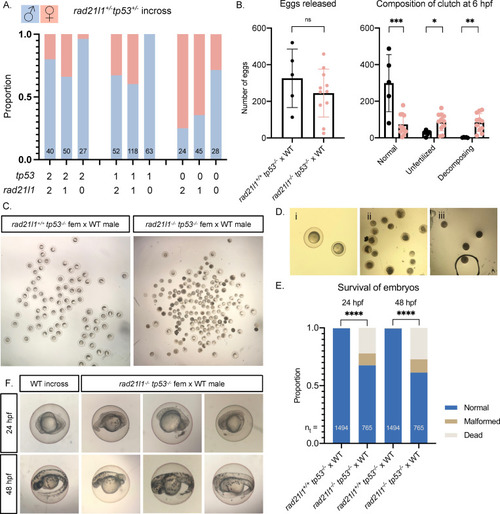|
<italic toggle='yes'>tp53</italic> knockout restores females to <italic toggle='yes'>rad21l1</italic> mutant population, but <italic toggle='yes'>rad21l1;tp53</italic> double mutant females produce poor quality eggs and malformed embryos.(A) Sex ratios of all genotypes resulting from a rad21l1+/-;tp53+/- incross. Data pooled from 3 crosses. 0, 1, and 2 on the x-axis refer to the number of wild-type copies of tp53 and rad21l1. (B) Data resulting from test crosses between rad21l1-/-;tp53-/- females and wild-type males to assess fertility and reproductive phenotype. rad21l1+/+;tp53-/- female tank mates used as controls. No significant difference in the number of eggs the females released. rad21l1-/-;tp53-/- double mutant females release a significantly greater percentage of eggs that fail to be fertilized or display premature decomposition. (C) Representative images of clutches from double mutant and control females at 6 hpf showing lower overall quality of eggs released from double mutant females. (D) Images i-iii show examples of eggs described in the text at 6 hpf. Panel i shows a normal egg (left) and a tiny egg (right). Panel ii shows prematurely decomposing eggs and panel iii shows opaque eggs. (E) Of normal embryos at 6 hpf, 32.4% are dead or malformed at 24 hpf and 38.7% by 48 hpf. Unpaired, two-tailed student t-test used for statistical analysis. (F) Representative images showing the range of malformations seen in developing embryos from rad21l1-/-;tp53-/- females at 24 and 48 hpf. ns = p>0.05, * = p<0.05, ** = p<0.01, *** = p<0.001.
|

